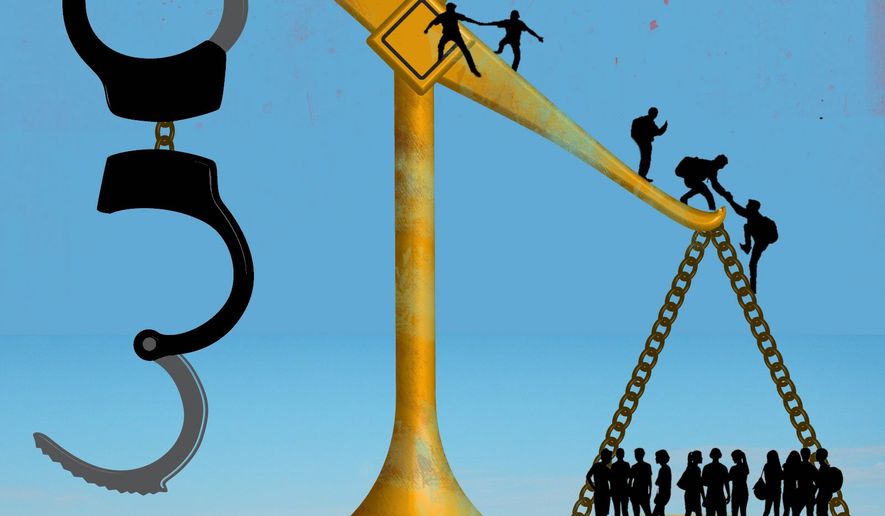OPINION:
President Biden’s recent executive orders and proposed immigration reforms are his down payment on an open border — something the majority of Americans don’t want but Democratic politicians would jam down our throats to harvest Hispanic voters.
Observe most construction sites, fast food restaurants or domestic cleaning services, and it is clear immigrants fill low-paying jobs native-born Americans are reluctant to take.
At the other end of the spectrum, American universities and other post-secondary technical programs train too few native-born Americans to meet the needs of the digital economy and rapidly emerging green industries. Foreign students that apply for visas and immigrants help fill the gap.
Over the past three decades, U.S. population and productivity growth have fallen. Those are the principal reasons the last three presidents struggled to boost economic growth above 2 percent and without more skilled immigrants, conditions could get worse.
About 45 million U.S. residents are foreign born and of those, about 11 million entered the country illegally. The distribution is bi-modal—about 28 percent have less than a high school education, and 32 percent hold a college degree or more.
Immigrants tend to be older than the native population, and 63 percent are estimated to qualify for means tested programs, as compared to 35 percent for the native population.
A definitive National Academy of Sciences study concluded immigrants boost GDP overall but push down the wages of less-skilled workers. That exacerbates inequality and contributes to cultural alienation in working class communities.
It pits well-educated, highly-paid Americans in large cities, who are comfortable with immigrants as colleagues and neighbors, against poorer native-born Americans squeezed out of manufacturing and into lower paying service employment by globalization, robots and artificial intelligence.
Poorer economic conditions at the bottom make life tougher for minorities and Whites in Middle America. And surely those added fuel to the violence and looting that accompanied Black Lives Matter demonstrations last summer and the mob that stormed the Capitol on Jan. 6.
In an effort to gain favor with the radical left, most of President Biden’s so-called reforms would throw gasoline on the fire.
About 1.1 million immigrants are legally admitted each year — 44 percent are close relatives of green card holder and citizens, 20 percent are distant relatives, 17 percent are on refugee and asylum status, and 4 percent entered through the diversity lottery. Only about 13 percent are admitted based on the skills and other needs of the economy.
Mr. Biden’s reforms would effectively grant amnesty to most illegal immigrants in the country prior to January 1, enable more family reunification arrivals, increase the diversity lottery from 55,000 to 80,000, and permit more asylum seekers to enter the country while awaiting hearings on their claims. The latter can then slip into the general population and become part of the illegal cohort if they have doubts, which many do, about their claims.
All of this will inspire even more Latin Americans to jump the border, encourage illicit smugglers and greatly increase the pool of unskilled workers at a time of deteriorating employment prospects for lower-paid Americans.
Mr. Biden says he will stem illegal arrivals by promoting Central American economic development and political reform, but we have been up and down that path before. From President Kennedy’s Alliance for Progress through the Obama Administration, U.S. efforts have failed, because the region bears huge cultural and geographic disadvantages that Mr. Biden’s $4 billion in aid are unlikely to overcome.
Instead, the branch offices of our immigration service Mr. Biden proposes to establish in Central America to process asylum seekers would further increase the flow of unskilled immigrants and further worsen conditions for working-class Americans.
The president also wants tougher border enforcement but as Yogi Berra would say, “it’s deja vu all over again.” In 1986, President Reagan signed a sweeping reform law that granted amnesty to 3 million illegal immigrants, beefed up enforcement and was sold as a crackdown.
Canada, Australia and New Zealand face challenge similar to ours — falling birth rates, skill shortages and societies defined by waves of immigrants from Europe and Asia — but award more than 60 percent of their combined visas based on skills.
Moving toward such a point system based on employers’ needs would accelerate economic growth, raise R&D spending, increase wages for lower-skilled Americans and ease inequality. But it would not please the radical left operatives bent on harvesting new voters for Democrats and who marionette the occupant of the Oval Office these days.
• Peter Morici, @pmorici1, is an economist and emeritus business professor at the University of Maryland, and a national columnist.




Please read our comment policy before commenting.